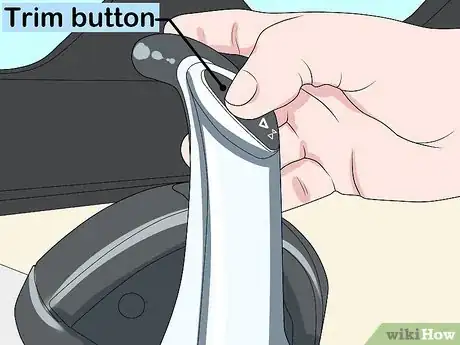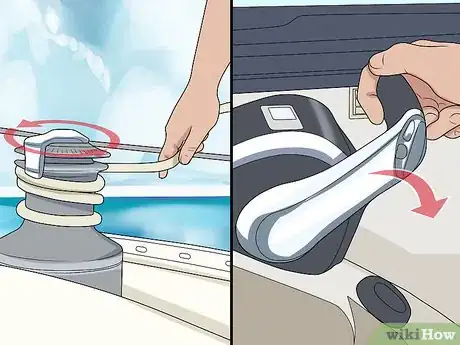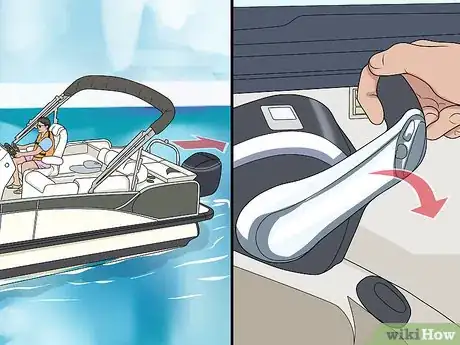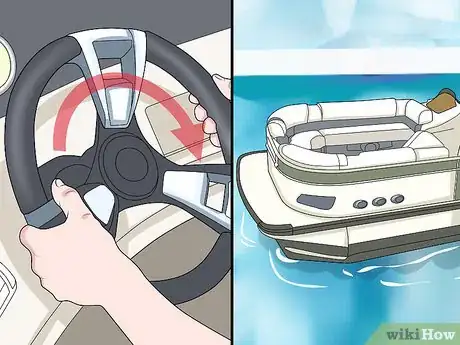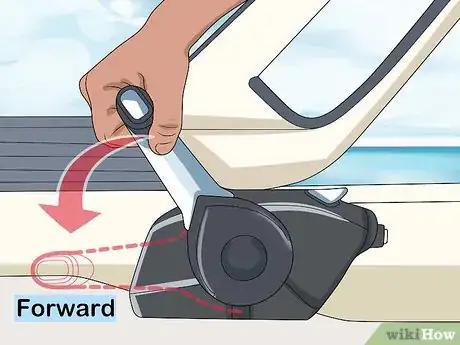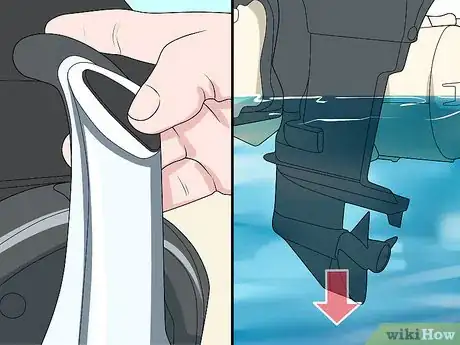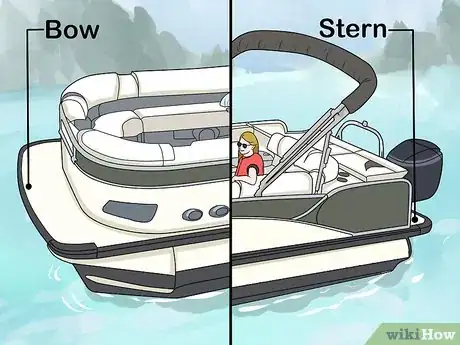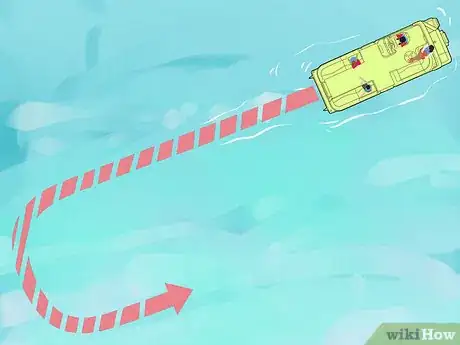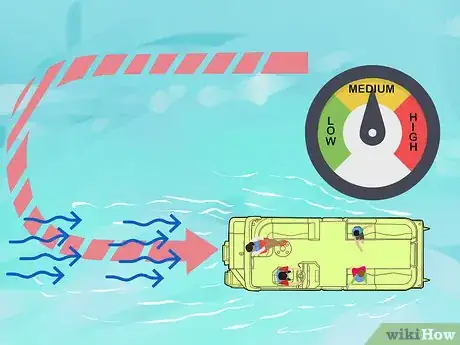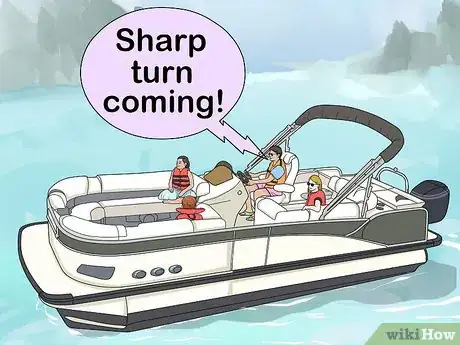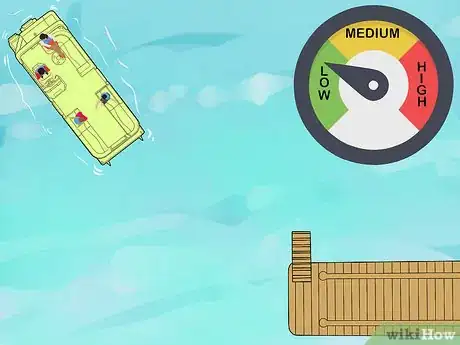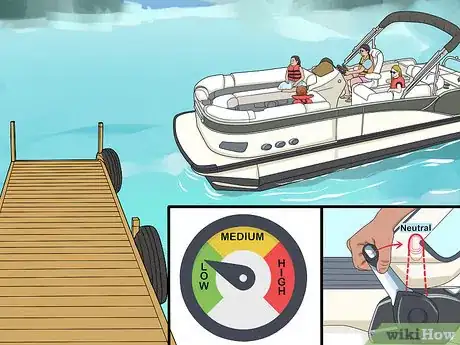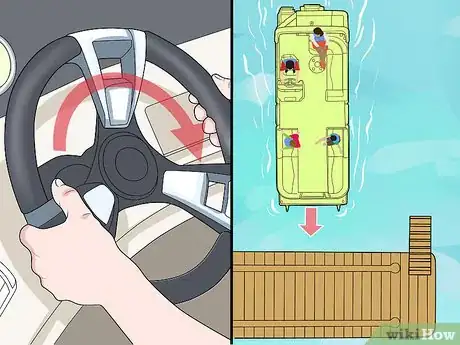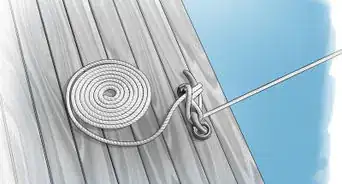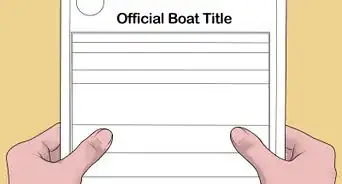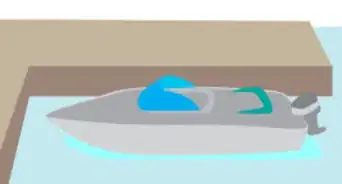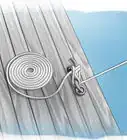This article was co-authored by Travis Lund. Travis Lund is the General Manager at the Vallejo Marina, a large marina located between the San Francisco Bay and the Delta in California. Sailing since he was six-years-old, Travis has over 15 years working in sailing operations and instruction and has pioneered a coaching platform that combined traditional coaching with multi-camera video support. He studied English at Michigan State University, where he was on the sailing team.
There are 11 references cited in this article, which can be found at the bottom of the page.
This article has been viewed 63,619 times.
A pontoon boat is a great option if you like to relax on the water, do water sports, or go fishing. These boats have a wide, flat bottom, giving you more room on the boat to lounge, walk, and sit. Driving a pontoon boat is not too different from driving a V-bottomed boat, but the difference in shape requires a few adjustments. Start by learning how to pull away from the dock with ease and navigate open waters. You should also know how to dock the pontoon in the slip, or parking spot, so it is safe and ready for your next boating adventure.
Steps
Pulling Away from the Dock and Taking Off
-
1Make sure all passengers are wearing life jackets. Before you move the boat at all, check that all your passengers are wearing life jackets or another personal flotation device, or PFD.[1] In most states, it is the law that all passengers wear life jackets while on open waters. The life jackets should fit properly and be in working condition.[2]
- Children should be wearing specialized jackets meant for their age groups.
- You should also have a cushion on the boat that you can throw to someone in the water in the event they are in distress.
-
2Check the fuel level and the radio on the boat. Make sure you have a full tank of gas in the boat, as this will ensure you can drive the boat on the water safely. You should also have a working radio system on the boat that you can use in the event of an emergency.[3]
- Make sure you also have your cellphone, fully charged, on hand so you can call for help or assistance if needed.
Advertisement -
3Secure all equipment on the boat. Check that items like fishing rods, wakeboards, coolers, and extra life jackets are all secure before starting the boat. You may use bungee cords to secure wakeboards and fishing rods. You can also push coolers against the sides of the boat so they are secure.[4]
-
4Start the motor and allow the boat to idle for 1-5 minutes. Turn the motor to “on.” Let the boat idle for several minutes so it can warm up. Check the manufacturer’s instructions for the exact idle time needed for your boat.[5]
-
5Trim the motor so it is in the water, but not too deep. The trim is how deep the motor on the boat sits in the water. There should be a “Trim” button on the throttle. Make sure the button is set at a higher number so the motor is just in the water. This will make pulling out of the dock much smoother.[6]
- You can also check the manufacturer’s instructions to see what the “Trim” button should be set at on the throttle for pulling out of the dock.
- Never pull out with the motor trimmed all the way up, as this will cause the boat to kick up water and could damage the engine. The motor should be touching the water when you pull out.
-
6Have a crew member untie the deck ropes as you put the throttle in “reverse.” Ask someone on the boat to lean over the sides and undo the deck ropes so the boat is no longer tied down. As they release the deck ropes, gently shift the throttle in reverse so you can back out. Make sure the person has regained their balance and is sitting firmly in the boat before you reverse the boat.[7]
- Move the throttle slowly and with ease. Do not pull it in reverse too quickly, as this can cause you to lose control of the boat.
-
7Back away slowly by pushing the throttle in short, controlled bursts. Look around you and behind you to make sure there are no obstructions, such as another boat or an animal. Then, back out of the dock slowly using short, controlled bursts on the throttle. Back out until you do not have any obstructions or boats in front of you or around you.[8]
-
8Turn the steering wheel so the bow points in the direction you want to travel. You want your bow to be facing into the wind, as this will help the boat to navigate smoothly in the water.[9]
-
9Shift into “forward” and move the throttle forward. Increase your speed in increments until you are cruising at a reasonable pace. Do not push down on the throttle hard and move off too quickly, as this can cause you to those control of the boat.[10]
- Always make sure you check that there are no obstructions in front of you before you move forward.
Driving in Open Water
-
1Keep the motor trimmed downward. Once you are in open water, adjust the “Trim” button on the throttle so it is at a lower number. This will trim the engine downward, deeper into the water. Trimming the engine downward will prevent the bow from rising too high when you get going on the water.[11]
- Keep one hand on the throttle and the other hand on the steering wheel as you drive the boat. This will make it easier for you to maintain the trim and steer the boat.
-
2Look 100 feet (30 m) ahead at all times. Be aware of your surroundings when you are in the boat. Scan the water ahead as you move forward. Use the side and back mirrors on the boat to check for any obstructions behind or to the side of the boat. This will ensure you are not at risk of hitting another boat, an animal, or driftwood in the water.[12]
- Before you make any turns or reverse the boat, double check your surroundings first.
-
3Maintain equal weight on the bow and the stern. Make sure there are people sitting or standing on the front and the back of the boat when you are moving in the water. If you have to accelerate or increase your speed, check that there is equal weight on the bow and stern before you accelerate so the boat is not at risk of flooding.[13]
- When the boat is idle in open water, the weight distribution is not too much of an issue. Ideally, it should be equal on the bow and stern as much as possible.
-
4Cruise at 4500 RPM or slower. Remember that boats do not have brakes, so you will need to maintain a cruising speed that is not too fast. Most pontoon boats should be kept at 4500 RPM in open waters. You can cruise at a lower speed if you want to conserve your fuel, at around 3000 to 3500 RPM.[14]
- A good rule of thumb is to accelerate gradually and maintain a speed that you feel you comfortable at. You should feel like you can easily slow down the boat at the cruising speed, if needed.
-
5Plan your turns in advance. Turning a pontoon boat can be tricky, as the stern can fly sideways if the turns are too sharp. Look ahead in front of you and plan out your turns so you can make them in a gentle, sweeping motion.[15]
- Planning out the turns will also help you to avoid making sharp or sudden turns.
-
6Turn the boat downwind at a medium speed. The wide shape of a pontoon boat can make turning into the wind difficult, as the boat may push against the wind and not get very far. You can turn more effectively by pointing the bow of the boat downwind, away from the direction of the wind, so the wind can help the boat to turn smoothly.[16]
- Make sure you are at a medium speed when you turn the pontoon. Turning at a very slow speed or a very fast speed can cause the boat to slide.
-
7Warn your passengers before you make a sharp turn. Sometimes when you are driving the pontoon boat, you have to make a sharp turn. Sharp turns can cause the boat to lean and rock due to its shape. Before you make the turn, let your passengers know so they can make sure they have braced themselves against the boat or they are sitting in a secure position.[17]
- For example, you may yell, “Sharp turn coming!” or “This turn is sharp!” so your passengers have enough of a warning.
Docking the Pontoon
-
1Slow down when you see the dock. Shift the throttle so you reduce your speed gradually as you spot the dock and move the boat towards it.
- Make sure you follow the harbor rules and slow down to the set speed limit around the dock or harbor.
-
2Accelerate downward and shift into neutral as you approach the slip. Do not approach the slip at a fast speed, as you risk hitting the boat on the dock. Maintain a slow, even speed so you have just enough power to maneuver the boat into the spot.[18]
-
3Turn the wheel so the center of the bow is pointing at the middle of the slip. Draw an imaginary line in an arc from the center of the bow to the middle of the slip. Try to keep your boat on this imaginary line as you turn the wheel. If the boat drifts to the left or right of the line, lightly move the wheel so it stays on the line.[19]
-
4Shift to “forward” as you turn. As you turn the wheel, gently shift the throttle forward so you can ease into the slip. Let momentum do most of the work so the boat can glide into the spot.[20]
-
5Shift into “reverse” to make small adjustments. If you end up slightly crooked or to one side in the slip, shift into “reverse” and turn the wheel slightly to make adjustments. Try to get the center of the bow lined up with the middle of the slip as much as you can.[21]
- Be aware of the wind and the current as you make adjustments, as they can affect the movement of the boat. Try move with the wind or current so you can straighten out the boat properly.
-
6Have a crew member jump on the dock and use the ropes to adjust the boat. If you are struggling to park the pontoon, ask a crew member to hop out and grab ahold of the ropes on the boat. Then, have them help you by dragging the boat into place using the ropes.[22]
- Direct the crew member as needed so you can get the pontoon straight in the slip.
-
7Tie the pontoon up on the dock. Once the pontoon is properly docked in the slip, use the ropes to secure the pontoon to the dock. Use a cleat hitch or a bowline knot to tie the boat to the dock so it stays in place.[23]
Expert Q&A
Did you know you can get expert answers for this article?
Unlock expert answers by supporting wikiHow
-
QuestionWhat are some safety precautions to know before I get on the water?
 Travis LundTravis Lund is the General Manager at the Vallejo Marina, a large marina located between the San Francisco Bay and the Delta in California. Sailing since he was six-years-old, Travis has over 15 years working in sailing operations and instruction and has pioneered a coaching platform that combined traditional coaching with multi-camera video support. He studied English at Michigan State University, where he was on the sailing team.
Travis LundTravis Lund is the General Manager at the Vallejo Marina, a large marina located between the San Francisco Bay and the Delta in California. Sailing since he was six-years-old, Travis has over 15 years working in sailing operations and instruction and has pioneered a coaching platform that combined traditional coaching with multi-camera video support. He studied English at Michigan State University, where he was on the sailing team.
Sailing Instructor & Executive Director, Treasure Island Sailing Center
Warnings
- Remember, before you leave the dock, always make sure someone on shore knows where you're going and how long you expect to be gone, as well as a list of everyone who's on board.[25]⧼thumbs_response⧽
References
- ↑ Travis Lund. Sailing Instructor & Executive Director, Treasure Island Sailing Center. Expert Interview. 24 April 2020.
- ↑ http://goneoutdoors.com/drive-pontoon-boat-4926038.html
- ↑ http://goneoutdoors.com/drive-pontoon-boat-4926038.html
- ↑ http://goneoutdoors.com/drive-pontoon-boat-4926038.html
- ↑ http://goneoutdoors.com/drive-pontoon-boat-4926038.html
- ↑ https://www.youtube.com/watch?v=ixmhK3_27yc&feature=youtu.be&t=87
- ↑ http://goneoutdoors.com/drive-pontoon-boat-4926038.html
- ↑ http://goneoutdoors.com/drive-pontoon-boat-4926038.html
- ↑ http://goneoutdoors.com/drive-pontoon-boat-4926038.html
- ↑ http://goneoutdoors.com/drive-pontoon-boat-4926038.html
- ↑ http://www.boats.com/how-to/how-to-handle-pontoon-boat/#.WdZYWBNSyRs
- ↑ https://www.youtube.com/watch?v=ixmhK3_27yc&feature=youtu.be&t=43
- ↑ https://www.youtube.com/watch?v=7UX0lPftkp8&feature=youtu.be&t=41
- ↑ http://www.boats.com/how-to/how-to-handle-pontoon-boat/#.WdZYWBNSyRs
- ↑ http://goneoutdoors.com/drive-pontoon-boat-4926038.html
- ↑ https://www.youtube.com/watch?v=7UX0lPftkp8&feature=youtu.be&t=85
- ↑ https://www.youtube.com/watch?v=7UX0lPftkp8&feature=youtu.be&t=24
- ↑ http://www.boats.com/how-to/how-to-dock-a-powerboat/#.WdZ6CBNSyRs
- ↑ http://www.boatsafe.com/nauticalknowhow/moredock.htm
- ↑ http://www.boatsafe.com/nauticalknowhow/moredock.htm
- ↑ http://www.boatsafe.com/nauticalknowhow/moredock.htm
- ↑ http://www.boats.com/how-to/how-to-dock-a-powerboat/#.WdZ6CBNSyRs
- ↑ http://www.christinedemerchant.com/my_ten_knots.html
- ↑ Travis Lund. Sailing Instructor & Executive Director, Treasure Island Sailing Center. Expert Interview. 24 April 2020.
- ↑ Travis Lund. Sailing Instructor & Executive Director, Treasure Island Sailing Center. Expert Interview. 24 April 2020.
About This Article
Driving a pontoon is similar to driving a vehicle, but because you’re on the water, there are slightly different safety procedures that you need to follow. Before you start driving, make sure that everyone on board is wearing a life jacket. Start the motor and let the boat idle for about 5 minutes so it can warm up. Then, adjust the trim, which is the depth of the propeller in the water, by pressing the button on the throttle so the motor is just in the water. Slowly back out using short, controlled bursts. Once you’re in open water, move the throttle forward and turn the steering wheel so the front of the boat is pointing in the direction you want to travel. Always look 100 feet ahead of you while you’re driving. When you want to turn the boat, slow down to medium speed and gently turn the wheel in the direction you want to go. To learn how to pull away from the dock when you’re driving a pontoon boat, keep reading!





